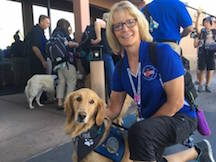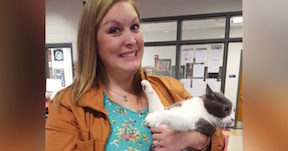How Much Does A Vet Visit Really Cost?
Rob Jackson, Healthy Paws Pet Insurance
 Research shows that 1 in 3 pets will need urgent vet care this year. Every 6 seconds an owner is given a vet bill more than $1000. This is why Rob Jackson, top dog at Healthy Paws Pet Insurance says you need his service. He'll tell us why only 1% of pet owners carry any kind of pet insurance.
Research shows that 1 in 3 pets will need urgent vet care this year. Every 6 seconds an owner is given a vet bill more than $1000. This is why Rob Jackson, top dog at Healthy Paws Pet Insurance says you need his service. He'll tell us why only 1% of pet owners carry any kind of pet insurance.
Rob Jackson is the CEO at Healthy Paws Pet Insurance. He tells us they had over a quarter million claims between 2016 and 2017. They've extrapolated the data and have come up with some interesting facts.
The primary reasons that anyone ends up at the veterinarian's office include a range of unexpected things. The one thing about pets is that they can't tell you what they just did. This makes it interesting, because the condition that is most often noted in veterinarian's records is, "ADR." This stands for "Ain't Doing Right!"
What happens is that a pet parent looks at their pet and they know something's not right. Perhaps their pet is not eating or they are just not themselves. They then take them to the vet and they have to start doing a whole bunch of different test to rule out things.
These days, the great news is they've got so many different types of diagnostic tests that they can usually find out what's going on. However, because the advances in veterinary care, the testing is more expensive now and oftentimes it may cost you $500 to $1,500 just to do the diagnostics. And, they still haven't even started to treat your pet.
For example, your dog could have eaten something that they weren't suppose to, because we know dogs get into all sorts of things. This is one of the unexpected things. Then of course you've got the various diseases like cancer.
 The bottom line is pet "parents" are the ones that buy health insurance. Pet "owners" really don't. Rob sort of defines a pet parent as someone who feels that their four-legged friend is a member of the family. Generally these people are going to be looking at making sure that they can always provide the best veterinary care for their pets.
The bottom line is pet "parents" are the ones that buy health insurance. Pet "owners" really don't. Rob sort of defines a pet parent as someone who feels that their four-legged friend is a member of the family. Generally these people are going to be looking at making sure that they can always provide the best veterinary care for their pets.
According to Rob's research, he claims that one in three pets will need urgent vet care this year and that every six seconds an owner is given a vet bill of more than $1,000. And, less than once percent of pet parents actually have pet insurance.
Rob explains that there are 85,000,000 households in the United States that have pets in them. And as of 2017, 1.8 million of those households actually have pet insurance. So it's starting to grow. But it's still a very, very small percentage. However, Rob does think that they are starting to see a little bit of an upward climb on that, as more people are really aware that pet health actually even exists. People are even finding out about it oftentimes at their work. It's starting to be a very popular voluntary benefit. Not that people are buying it a lot, but Rob thinks they're finding out that pet health insurance is actually an option.
So how do you pick pet insurance? What is the best time to get pet health insurance? You have to keep in mind that there are certain breeds of animals that are predisposed to certain conditions like hip dysplasia and leg problems. So should you get the insurance before those set in?
Rob explains that pre-existing conditions are probably one of the most important things you need to consider when buying pet insurance, because pre-existing conditions that are not covered by anybody. This is obvious, otherwise people would just wait around until something shows up and then go ahead and buy the insurance on it.
 The best time to get pet insurance is when your pet is in the starting gate of life. If you can do that, then what you have really done is reduced the odds that a pre-existing conditions are going to decrease your coverage. Even if your dog has hereditary congenital conditions, as long as the clinical symptoms are not present prior to enrollment, those are going to be covered down the road. Sometimes people say, "Oh, well, you know, mines just a puppy. I'll wait until three or four years old." Rob can tell you, that puppies get into a heck of a lot of trouble. In fact, there are frequent claims on puppies just because they ate something they shouldn't have. So you are better off to get that pup enrolled or that kitty enrolled right off the bat. In fact, rob tells us that he actually sees a little bit of a reduction after one and one half years until around the age of four.
The best time to get pet insurance is when your pet is in the starting gate of life. If you can do that, then what you have really done is reduced the odds that a pre-existing conditions are going to decrease your coverage. Even if your dog has hereditary congenital conditions, as long as the clinical symptoms are not present prior to enrollment, those are going to be covered down the road. Sometimes people say, "Oh, well, you know, mines just a puppy. I'll wait until three or four years old." Rob can tell you, that puppies get into a heck of a lot of trouble. In fact, there are frequent claims on puppies just because they ate something they shouldn't have. So you are better off to get that pup enrolled or that kitty enrolled right off the bat. In fact, rob tells us that he actually sees a little bit of a reduction after one and one half years until around the age of four.
So don't play pet insurance roulette. The best thing is to go ahead and get it. And usually the premiums are a little bit lower when they are younger too.
Also, if you have a breed of dog that is known to get into things, like a Labrador Retriever, these puppies tend to explore it and ingest everything in their environment, so you really ought to consider getting pet insurance, because more than likely a Labrador later will prove to test that.
Visit Website
Comforting Schoolchildren After Shootings
Bonnie Fear, Cubby The Comfort Dog
 When students and teachers returned to a Marjory Stoneman Douglas High School in Florida after the tragic Valentine's Day shooting that left 17 dead, a team of Golden Retrievers were there to offer comfort and hope. One of those dogs was Cubby from Fort Collins.
When students and teachers returned to a Marjory Stoneman Douglas High School in Florida after the tragic Valentine's Day shooting that left 17 dead, a team of Golden Retrievers were there to offer comfort and hope. One of those dogs was Cubby from Fort Collins.
Cubby is female Golden Retriever named. She was named after a military dog that served our country in the air force. Her whole litter was actually named after a fleet of military dogs. Cubby was one of 30 dogs that visited this school after the tragedy.
When these dogs visited the school, Bonnie Fear, who is Cubby' handler, told us that the kids just smiled when they saw the dogs. She said if you looked in their eyes, you could tell that they were happy and were able to release that insecurity or that uncertainty of returning to school two weeks after the shooting.
There are a lot of therapy dogs that do a variety of things. They go to hospitals and visit sick children. However, these dogs are they trained just for comforting. Bonnie explains that a therapy dog is a pet. It's someone's pet that they want to take out and serve a purpose. So they do the local training to certify them as a therapy dog.
Cubby is not someone's pet. She is actually owned by Redeemer Lutheran Church in Fort Collins. This means volunteers sponsor her. Currently, their team has 24 volunteers. Ten of those are handlers and another ten of those are what they call Paw Partners. The Paw Partners help the handlers when they take the dogs out into the community. They also have people who pray specifically for the dogs and their teams. Cubby even has her own scheduler.
Cubby has 11 places in the community when she's not deployed that she visits weekly. The handlers keep on top of the timing and make sure that cubby gets to those visits.
Cubby is one of 11 Lutheran Church Charities K-9 Comfort Dogs from around the country who visited the school that week and among 30 total who have offered comfort since the shooting. They are bred and trained in North Brook, Illinois and they are all Golden Retrievers. They receive about 2,000 or more hours of training specifically to remain calm in crisis or disaster situations. The charity started in 2008 and they have grown from four dogs to over 130 dogs.
 When Cubby flies on airplanes to visit disaster sites, if you don't see her get on the plane, you don't know she's on the plane. They're, they're trained to be quiet and just bringing that comfort and hope to people who are hurting
When Cubby flies on airplanes to visit disaster sites, if you don't see her get on the plane, you don't know she's on the plane. They're, they're trained to be quiet and just bringing that comfort and hope to people who are hurting
Bonnies explains that cubby loves her job, which has two aspects to it. One is when, and bonnie speaks for all of these dogs, when their vest is on they know they're working and they're trained that way. When they are puppies, as early as 8 weeks old, eight weeks old, they are trained in their vests.
Bonnie thinks the best part for all the dogs is when the vest comes off and they get a command called, "Go Play." They then become a regular dog. They can play with their balls or their toys or other dogs.
So Lutheran Church Charities has a program where they train a dog until it passes, which is called "passing of the vest." The dog then goes to the church that officially gets dog after it's fully trained.
Lutheran Church Charities feels that Golden Retrievers has the best demeanor for this job. They are so calm and just receptive to people. They love people, just as most dogs do, but the Golden Retrievers is probably easier to train because they are so mellow and just catch on very quickly.
Visit Website
Visit Facebook
Visit Instagram
E-Cigarette Toxicity in Pets -Dr. Debbie
 Think that vapor cigarettes (a.k.a. electric cigarettes or e-cigarettes) are a healthier alternative to traditional cigarettes? The vapor habit might be better for you and decrease your pet's exposure to second hand smoke, but can increase the chance of a pet's toxic ingestion of nicotine. A story from England told of the tragic death of a puppy that died after chewing on an e-liquid container.
Think that vapor cigarettes (a.k.a. electric cigarettes or e-cigarettes) are a healthier alternative to traditional cigarettes? The vapor habit might be better for you and decrease your pet's exposure to second hand smoke, but can increase the chance of a pet's toxic ingestion of nicotine. A story from England told of the tragic death of a puppy that died after chewing on an e-liquid container.
Ivy was a 14 week on Staffordshire Bull Terrier that chewed on her owner's bottle of e-liquid used to refill the electric cigarettes. Within 30 seconds of nibbling on the container, she fell sick with vomiting and disorientation and was rushed to a veterinary office. Sadly Ivy died within 24 hours due to heart and respiratory failure.
What's in e-liquid?
The ingredients in e-liquid vary but include carriers such as propylene glycol, polyethylene Glycol 400 and vegetable glycerin, as well as flavoring agents and nicotine. The amount of nicotine in e-liquid varies with some products not containing any nicotine, to others ranging from 18 mg/ml to 100mg/ml.
How toxic is nicotine?
The toxic dose of nicotine for pets is 0.5 to 1mg per pound of body weight. The fatal dose is 4mg per pound. So if you consider a 20 pound dog, toxicity would occur if 10mg were ingested, and the pet would die if 80mg were ingested. Therefore with the high nicotine levels in e-liquid, it wont take much to reach those fatal levels. That hypothetical 20 pound dog could die from less than 1ml of the highest potency liquid nicotine.
Pets likewise can develop toxicity if other sources of nicotine are ingested such as cigarettes, chewing tobacco, nicotine gum, or nicotine nasal sprays. The typical amounts of nicotine in these products are: Cigarette 9-30 mg; Nicotine gum 2 - 4 mg per pieces; and Nicotine patches 8.3 - 114 mg.
 Even cigarette butts can be toxic if enough are ingested - cigarette butts retain 25-percent of the nicotine in the original cigarette.
Even cigarette butts can be toxic if enough are ingested - cigarette butts retain 25-percent of the nicotine in the original cigarette.
What are symptoms of nicotine poisoning?
Symptoms usually develop within one hour of ingestion. Pets may display excitability, rapid heart rate, drooling, vomiting, diarrhea, weakness, seizures, and coma.
How are pets treated for nicotine toxicity?
The first step is to decontaminate by inducing vomiting. Nicotine typically causes vomiting when ingested, but further decontamination is advised at the veterinary office. Other emergency care includes intravenous fluids, medications to manage elevated blood pressure and heart rate, and anti-seizure medications. Nicotine is metabolized by the liver and excreted within 16 hours after ingestion. Pets that survive the initial four hours after ingestion have a favorable chance of survival.
The vapor cigarette trend is becoming more popular world wide. It's important to recognize that nicotine is a toxin and poisonous to animals and children. Consider the e-liquid a hazardous material and store it safely in a locking cabinet, away from children and pets.
To read more about Ivy's toxicity after ingesting E-fluid go to "Dog dies after chewing e-fluid container."
Featured veterinarian known as "Dr. Debbie" on national pet radio program, Animal Radio. Ebook author of "Yorkshire Terriers: How to Be Your Dog's Best Friend"; "Pugs: How to Be Your Dog's Best Friend"; "Mini Schnauzers: How to Be Your Dog's Best Friend"; and "Shih Tzu: How to Be Your Dog's Best Friend." Dr. Debbie's books.
Visit Website
Animal Radio News - Lori Brooks
 Read The Fine Print When Shipping Animals
Read The Fine Print When Shipping Animals
A New York state appeals court has ruled that Delta Air Lines is liable for only $50 in the case of a New York woman whose 8-week-old Savannah kitten suffered a broken hip while being shipped by the airline in the cargo hold to LaGuardia Airport in New York in 2015. The decision by the appellate court reversed a lower court ruling that had favored the woman, who bought the kitten from a breeder in Florida for $2,300. Let this be a lesson to read the fine print. The four-judge appeals court said the "air waybill" for shipping the kitten via Delta's cargo service limited the airline's liability and that the federal Airline Deregulation Act of 1979 preempted potential claims under New York state law.
 Women Could Be Harming Their Pets
Women Could Be Harming Their Pets
New research shows women may be unknowingly harming dogs by exposing them to toxic chemicals. Why just women? Because, the culprit in this case are cosmetics and makeup, which could be triggering chronic illnesses. This can ultimately lead to the death of pets by wreaking havoc on their developmental, neurological and reproductive systems by disrupting the body's endocrine system - mostly hormones. Specifically, it is parabens, which are used as preservatives in cosmetics and moisturizers that are causing the problems. Experts say it could explain why dogs that live indoors have increased rates of diabetes, kidney failure and hypothyroidism compared with those that pets that live outside. Both cats and dogs can ingest parabens found in their food, but urine tests show dogs that were tested had a paraben level 7 times higher than cats. For some reason, cats are primarily exposed to parabens in their food. However, much higher level of parabens found in the dogs that were tested mean the paraben exposure has to be coming from sources other than their food. So-called endocrine-disrupting chemicals are found in thousands of everyday products, ranging from plastic and metal food containers, to detergents, flame retardants, toys and cosmetics.
 Microchip Reunites Cat With Family After 14 Years
Microchip Reunites Cat With Family After 14 Years
An orange tabby cat named Thomas Jr., who was missing for 14 years, or about 72 years in cat time, has been reunited with his dad in Florida. Thomas Jr., or T2 as he is called, went missing in 2004 after a hurricane. Luckily, T2 had been implanted with a microchip two years earlier. Since T2's escape, his dad has moved twice, once to Ohio and then back to Florida. But thanks to the dad's microchip information being up to date it was very easy for the shelter to find him. FYI: The chances of a microchipped dog being found and returned to its owner rise from 25-percent to 50-percent. For cats, it's 2-percent without a chip vs. 25-percent with one.
3-Strikes For United
Already under scrutiny about a French bulldog dying in an overhead bin and another dog being accidentally sent to Japan, United Airlines has acknowledged its third animal-related mistake in just that week earlier this month. This latest case happened when a United flight was diverted to Akron, Ohio after the airline realized a pet had been loaded onto the flight by mistake. That plane was headed to St. Louis, Missouri with 33 passengers. What do you do when you're an airline that's had as bad of a week for pet disasters as United had? You get that dog to where it was supposed to be - never mind the 33 passengers that are supposed to be going to St. Louis. You take those passengers along for an emergency drop off of the dog in Akron, Ohio. If you hadn't heard, before that lucky dog was dropped off in Ohio, on Tuesday of that week, a 10-year-old German Shepherd was flown to Japan when he was supposed to end up in Kansas, but in his place was a Great Dane that was really supposed to be en route to Japan. Just one day before that, a French bulldog died on a flight from Houston to New York after a flight attendant told its owners to put the dog, in its carrier, in the overhead bin. The airline says the attendant did not hear or understand that there was actually a dog in the carrier. So in order to prevent another situation like that, United says it will issue bright-colored bags to customers traveling with in-cabin pets so the visual of the bright color will help flight attendants to identify pets in the passenger cabin.
 Google "Dog" Views
Google "Dog" Views
Google Street View usually only provides one point of view - the human point or perspective. Now, Google Japan will give users a sense of what a place looks like to a dog by attaching a small camera to a harness on the backs of three Akita dogs. Ironically the first city where they've done this is the birthplace of the Akita breed. It adds a special touch too that you can see their fluffy ears and curly tails as you pivot around in any spot.
 Student Brings Cat To School in Backpack
Student Brings Cat To School in Backpack
Mrs. Geipel, a fourth-grade teacher in Virginia, and a co-worker heard meowing in her classroom recently but a quick look out the window revealed no cat. They then began to search for what they thought would be a meowing ringtone on a student's phone. Nope, wrong again. The teacher finally located the sound and it was coming from a backpack that had a jacket over it. So the teacher called the student's parents who came and picked up what turned out to be their neighbor's cat.
 Listen to the entire Podcast of this show (#956)
Listen to the entire Podcast of this show (#956)





